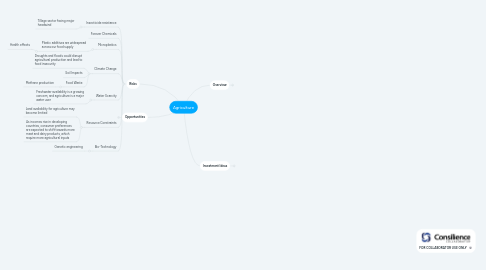
1. FOR COLLABORATOR USE ONLY
2. Risks
2.1. Insecticide resistance
2.1.1. Tillage sector facing major headwind
2.2. Forever Chemicals
2.3. Microplastics
2.3.1. Plastic additives are widespread across our food supply
2.3.1.1. Health effects
2.4. Climate Change
2.4.1. Droughts and floods could disrupt agricultural production and lead to food insecurity
2.4.2. Soil Impacts
2.4.3. Food Waste
2.4.3.1. Methane production
2.5. Water Scarcity
2.5.1. Freshwater availability is a growing concern, and agriculture is a major water user
2.6. Resource Constraints
2.6.1. Land availability for agriculture may become limited
2.6.2. As incomes rise in developing countries, consumer preferences are expected to shift towards more meat and dairy products, which require more agricultural inputs
2.7. Bio-Technology
2.7.1. Genetic engineering
3. Opportunities
3.1. Bio-Technology
3.1.1. Genetic Engineering
3.1.1.1. Changes in crop yields and breeding
3.1.1.2. Abiilty to mitigate the impact of diseases and pests
3.1.1.3. Soil composition changes
3.1.1.3.1. Food quality changes and more nutritious foods
3.1.1.4. Food security
3.1.1.4.1. Health benefits
3.1.2. Productivity and Efficiencies
3.1.2.1. Gene Editing
3.1.2.2. Surplus Land Use
3.1.2.2.1. Used as carbon sinks
3.1.2.2.2. Used for biofuels
3.2. Start-ups
3.2.1. Start-ups actively investing in new paradigms, focusing on revolutionary shifts in various sectors such as agriculture, embracing soil complexity, robotics, and other transformative technologies present opportunities
3.3. Technological Advancements
3.3.1. Precision agriculture, using data and automation to optimize resource use, is poised to improve efficiency and yields
3.3.2. Innovations in areas like gene editing and vertical farming could further revolutionize production
3.4. Geopolitical
3.4.1. Trade
3.5. Rising Demand
3.5.1. Fertilizer demand
3.5.1.1. Farmers are coming back into the market
3.5.1.1.1. U.S
3.5.1.1.2. Brazil
3.5.1.1.3. India
3.5.2. The global population is projected to continue growing, albeit at a slower pace
3.5.2.1. Global food supply crisis discussed prompts advocating for reduction in meat and fish production due to sustainability concerns
3.6. Health benefits
3.6.1. Shifting Diets
3.7. Potential Growth Areas
3.7.1. Precision agriculture technologies
3.7.2. Sustainable farming practices
3.7.3. Alternative proteins and cultivated meat
3.7.4. Vertical farming and indoor agriculture
3.8. Increasing Demand
3.8.1. Farmers are coming back into the market
3.8.1.1. U.S
3.8.1.2. Brazil
3.8.1.3. India
3.9. Focus on Sustainability
3.9.1. Consumer awareness of environmental issues is driving demand for sustainable farming practices
4. Overview
4.1. Fields
4.1.1. Crop Production
4.1.1.1. This involves growing a wide variety of plants for food, fiber, fuel, and other uses
4.1.2. Forestry
4.1.2.1. Agroforestry
4.1.2.1.1. Forestry will provide real value moving forward and are going to become the farms of the future with the help of robots and drones
4.1.3. Animal Production
4.1.3.1. This involves raising livestock for meat, milk, eggs, and other products
4.1.4. Bio-Economies
4.1.4.1. The use of plant-based carbon in lieu of fossil fuels
4.1.4.1.1. Sustainable farming, forestry, fisheries and supporting activities
4.1.4.1.2. Sustainable products
4.1.5. Agribusiness
4.1.5.1. Value chains in agriculture and in the bio-economy
4.1.6. Fisheries
4.1.6.1. Aquaculture
4.1.7. Supporting Activities
4.1.7.1. Equipment manufacturers, fertilizer and pesticide companies, seed suppliers, transportation companies, and food processing facilities
4.2. Industry
4.2.1. Current Size (2023)
4.2.1.1. The global agriculture market grew from $12,245.63 billion in 2022 to $13,398.79 billion in 2023 at a compound annual growth rate (CAGR) of 9.4%.
4.2.2. Growth projections
4.2.2.1. Gross production value in Agriculture market is projected to amount to US$3.90tn in 2024
4.2.2.2. An annual growth rate of 5.66% is expected (CAGR 2024-2028), resulting in gross production value of US$4.86tn in 2028.
4.3. Major Players
4.3.1. Agricultural Product Companies
4.3.1.1. Wilmar International (Singapore)
4.3.1.2. Cargill (US)
4.3.1.3. Archer Daniels Midland (ADM) (US)
4.3.1.4. Bunge (Switzerland)
4.3.1.5. Bayer (Germany)
4.3.2. Farm Equipment Manufacturers
4.3.2.1. Deere & Company (John Deere) (US)
4.3.2.2. CNH Industrial (Italy/US)
4.3.2.3. AGCO Corporation (US)
4.3.3. Smart Agriculture Companies
4.3.3.1. Trimble Inc. (US)
4.3.3.2. Deere & Company (John Deere) (US)
4.3.4. Seed and Fertilizer Companies
4.3.4.1. Corteva Agriscience (US)
4.3.4.2. The Mosaic Company (US)
4.3.4.3. Yara International (Norway)
4.3.4.4. Nutrien (Canada)
4.3.5. Agricultural Cooperatives
5. Investment Ideas
5.1. Forgotten Crops
5.2. Agri-Tech
5.2.1. Robotics
5.2.1.1. AI
5.2.2. Drones
